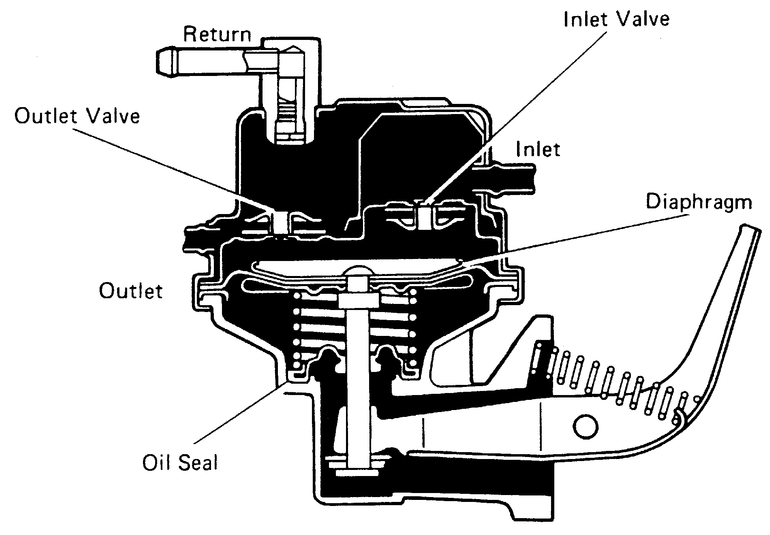Unlocking Small Engine Power: The Vacuum Fuel Pump
Ever wonder how your lawnmower or chainsaw consistently gets the fuel it needs? It's more than just gravity. Often, a small but mighty component is at play: the vacuum fuel pump. These unsung heroes are essential for many small engines, ensuring a steady flow of fuel for optimal performance.
The vacuum fuel pump for small engines is a simple yet ingenious device that leverages engine vacuum pressure to draw fuel from the tank and deliver it to the carburetor. This allows for more efficient fuel delivery, especially in applications where gravity alone isn't enough, such as in equipment with complex fuel tank placements or when working on inclines.
Unlike larger engines that may use mechanical pumps, small engine vacuum fuel pumps offer a cost-effective and relatively low-maintenance solution. Their compact size and reliance on engine vacuum simplify installation and reduce the overall engine complexity. This makes them ideal for a wide range of applications from lawn and garden equipment to portable generators and small off-road vehicles.
Understanding how these pumps work is essential for anyone who owns or maintains small engine equipment. A malfunctioning fuel pump can lead to starting issues, rough running, or even complete engine failure. This article delves into the workings of vacuum fuel pumps in small engines, covering everything from their history and functionality to troubleshooting and maintenance.
While the precise origin of the vacuum fuel pump for small engines is difficult to pinpoint, their development parallels the rise of small gasoline engines in the early 20th century. As engine designs evolved, so did the need for more reliable fuel delivery systems. The simplicity and effectiveness of vacuum-operated pumps made them a natural choice for these smaller power plants. Over time, they became a standard component in countless applications.
A vacuum fuel pump operates by using the pressure difference created by the engine's intake manifold. As the engine runs, it creates a vacuum. This vacuum is channeled to the fuel pump diaphragm chamber. The diaphragm, a flexible membrane, moves in response to the pressure difference, creating a pumping action that draws fuel from the tank through an inlet valve and pushes it towards the carburetor through an outlet valve.
One benefit of using a vacuum fuel pump is simplicity. These pumps have fewer moving parts than mechanical fuel pumps, reducing the chance of mechanical failure. Another benefit is cost-effectiveness. They are generally less expensive to manufacture and replace than their mechanical counterparts. Lastly, their compact size makes them ideal for the space constraints often found in small engine designs.
Troubleshooting a vacuum fuel pump typically involves checking for leaks in the fuel lines and diaphragm, and ensuring proper vacuum pressure from the engine. A simple test can be performed by disconnecting the fuel line from the carburetor and checking for fuel flow while the engine is running.
Advantages and Disadvantages of Vacuum Fuel Pumps
| Advantages | Disadvantages |
|---|---|
| Simplicity and fewer moving parts | Dependent on engine vacuum |
| Cost-effective | Can be susceptible to vapor lock in hot conditions |
| Compact size | Limited fuel pressure compared to mechanical pumps |
Five common challenges with vacuum fuel pumps include diaphragm failure, clogged fuel lines, cracked fuel lines, loss of engine vacuum, and vapor lock. Solutions include replacing the diaphragm, cleaning or replacing fuel lines, restoring engine vacuum, and using heat shields to prevent vapor lock.
FAQ: What is a vacuum fuel pump? How does a vacuum fuel pump work? How do I test a vacuum fuel pump? What are the signs of a bad vacuum fuel pump? How do I replace a vacuum fuel pump? How do I prevent vacuum fuel pump problems? What causes a vacuum fuel pump to fail? Where is the vacuum fuel pump located on a small engine?
Tips and tricks for maintaining your vacuum fuel pump: Regularly inspect fuel lines for cracks or leaks. Use a fuel stabilizer to prevent fuel degradation. Ensure proper engine maintenance to maintain consistent vacuum pressure. Check and clean the fuel filter periodically.
In conclusion, the vacuum fuel pump plays a vital role in the operation of numerous small engines, from lawnmowers and chainsaws to generators and pressure washers. Its simple yet effective design provides a reliable and cost-effective way to deliver fuel to the carburetor, ensuring smooth and efficient engine performance. Understanding its functionality, potential issues, and maintenance requirements is crucial for anyone who owns or operates small engine equipment. By following the tips and guidelines outlined in this article, you can help ensure the longevity and reliability of your small engine's vacuum fuel pump, keeping your equipment running smoothly for years to come. Investing time in understanding this crucial component can save you time, money, and frustration in the long run, empowering you to maintain your equipment and keep it performing at its best.
Rav4 prime plug in hybrid an in depth review
Decoding march madness navigating the cbs sports bracket landscape
Upgrade your home with behr paint primer from home depot














